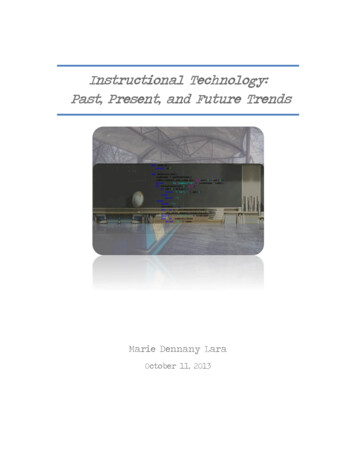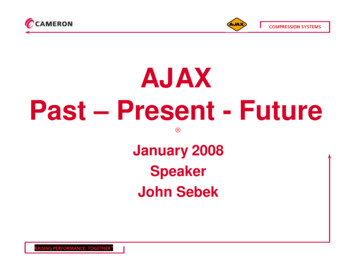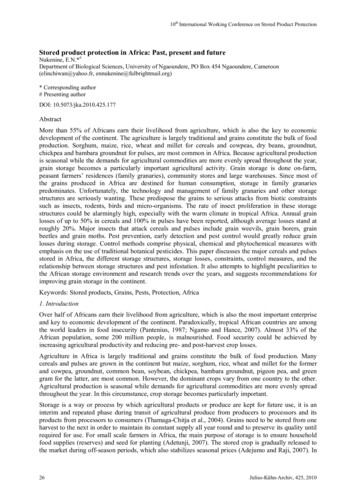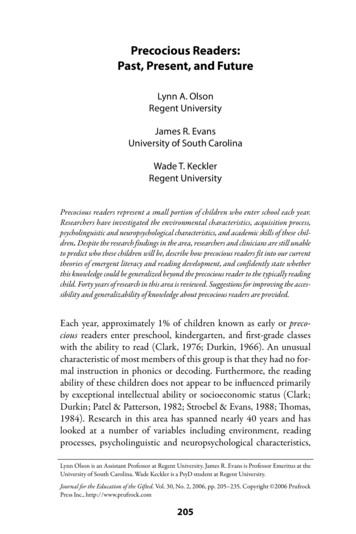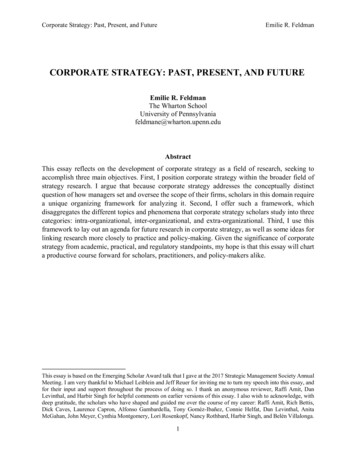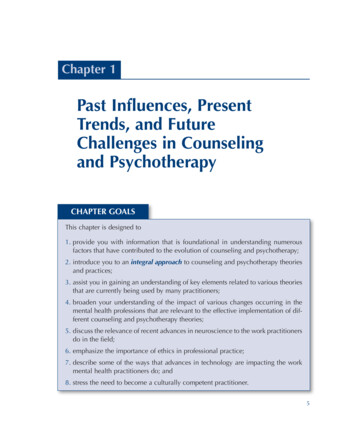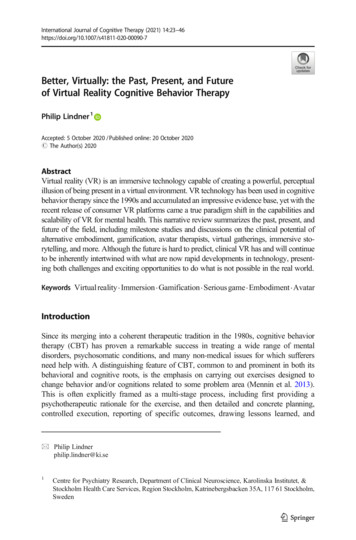
Transcription
International Journal of Cognitive Therapy (2021) -7Better, Virtually: the Past, Present, and Futureof Virtual Reality Cognitive Behavior TherapyPhilip Lindner 1Accepted: 5 October 2020 / Published online: 20 October 2020# The Author(s) 2020AbstractVirtual reality (VR) is an immersive technology capable of creating a powerful, perceptualillusion of being present in a virtual environment. VR technology has been used in cognitivebehavior therapy since the 1990s and accumulated an impressive evidence base, yet with therecent release of consumer VR platforms came a true paradigm shift in the capabilities andscalability of VR for mental health. This narrative review summarizes the past, present, andfuture of the field, including milestone studies and discussions on the clinical potential ofalternative embodiment, gamification, avatar therapists, virtual gatherings, immersive storytelling, and more. Although the future is hard to predict, clinical VR has and will continueto be inherently intertwined with what are now rapid developments in technology, presenting both challenges and exciting opportunities to do what is not possible in the real world.Keywords Virtual reality . Immersion . Gamification . Seriousgame . Embodiment . AvatarIntroductionSince its merging into a coherent therapeutic tradition in the 1980s, cognitive behaviortherapy (CBT) has proven a remarkable success in treating a wide range of mentaldisorders, psychosomatic conditions, and many non-medical issues for which sufferersneed help with. A distinguishing feature of CBT, common to and prominent in both itsbehavioral and cognitive roots, is the emphasis on carrying out exercises designed tochange behavior and/or cognitions related to some problem area (Mennin et al. 2013).This is often explicitly framed as a multi-stage process, including first providing apsychotherapeutic rationale for the exercise, and then detailed and concrete planning,controlled execution, reporting of specific outcomes, drawing lessons learned, and* Philip Lindnerphilip.lindner@ki.se1Centre for Psychiatry Research, Department of Clinical Neuroscience, Karolinska Institutet, &Stockholm Health Care Services, Region Stockholm, Katrinebergsbacken 35A, 117 61 Stockholm,Sweden
24International Journal of Cognitive Therapy (2021) 14:23–46progressing to the next exercise. Since exercises are so central in CBT—congruent with itshistorical emphasis on specific as opposed to common factors (Buchholz and Abramowitz2020)—this therapeutic tradition is inherently well suited for technology-mediated delivery formats that do not rely on there being a traditional client-therapist relationship. Therapid, paradigm shifting and often unpredictable development and dissemination in thelast decades of different consumer information technologies (everything from personalcomputers to portable media players, smartphones, and wearables) have allowed researchers and clinicians to explore new avenues for treatment design and delivery. Aprominent success story of the merger of technology and psychotherapy is Internetadministered CBT (iCBT), which enjoys a robust evidence base with demonstratedefficacy equivalent to face-to-face treatments for mental disorders and psychosomaticconditions (Carlbring et al. 2018), and is now implemented in routine care in manycountries (Titov et al. 2018). iCBT, as it is typically packaged, is in essence a digital formof bibliotherapy: a virtual self-help book where modules replace chapters, delivered not onpaper but via an online platform, with or without support from an online therapist (oftenthrough asynchronous messaging). These modules convey in writing what would otherwise be conveyed orally in the face-to-face format, covering both psychoeducation andexercises. The bibliotherapeutic roots of iCBT are apparent in that many trials adaptedexisting self-help books (Andersson et al. 2016) or have afterwards been published as such(Carlbring et al. 2001).Without any doubt, iCBT was certainly revolutionary at the time of the first appearance, challenging entrenched preconceptions of what psychotherapy is, offering unlimited dissemination of evidence-based treatment, and raising the scientific standard ofpsychotherapy research to that of the medical field (Andersson 2016). The novelty ofiCBT however lied in the format of delivery, not the therapeutic content. Withimmersive technology like virtual reality (VR), it is possible to revolutionize not onlyhow treatment is delivered but also how change-promoting experiences are designedand evaluated, by making the unrealistic a reality. This narrative review will introducereaders to VR technology and how it can be put to clinical use, and discuss the past,present, and future of VR-CBT for mental disorders. The aim is not to provide asystematic review (Freeman et al. 2017) or a meta-analysis of the field (Botella et al.2017; Carl et al. 2018; Wechsler et al. 2019) but rather to give a historical overview andcontext, showing how developments in technology have fueled clinical progress.Perspectives on the future of the field will also be provided. The focus will be on VRCBT treatments for anxiety disorders since this application dominates the extant literature, although other clinical applications will also be discussed. In addition to being atreatment tool, VR is also seeing increasing use as an experimental platform for studyingpsychopathology (Juvrud et al. 2018) and treatment mechanisms (Scheveneels et al.2019); coverage of this exciting application is however beyond the scope of this review.What Is Virtual Reality?In essence, VR refers to any technology that creates a simulated experience of beingpresent in a virtual environment that replaces the physical world (Riva et al. 2016). Thissense of (virtual) presence is a key concept in VR and is what distinguishes thistechnology from others along the so-called mixed reality spectrum: someone playing
International Journal of Cognitive Therapy (2021) 14:23–4625a traditional video game, for example, or even reading a captivating book, may verywell become immersed in it but is unlikely to feel physically transported to the localedepicted on their computer screen. Experiencing presence in VR is a powerful perceptual illusion, yet an illusion nonetheless: the environment may indeed prompt overtcognitions like “I know this is not real”—as individuals undergoing VR exposuretherapy often think and say aloud as a safety behavior—yet this is done after the sameuser has already acted congruent with the environment, thereby demonstrating that it isnonetheless perceived as real (Slater 2018).To create this perceptual illusion, special hardware is required. As will be discussedin the coming sections, until only a few years ago, such hardware was inaccessible,expensive, and required trained professionals to both develop software for and use.While it is possible to transform a (restricted) physical environment into a virtual oneby projecting interactive images onto the walls—a so-called CAVE setup (Bouchardet al. 2013)—developments in head-mounted display (HMD) technology has made thislatter VR approach the dominant one, especially with the release of consumer VRplatforms that are all of the HMD kind. Modern VR HMDs come in two versions:mobile devices, either freestanding or smartphone-based, and tethered devices. Mobiledevices offer simplicity of use and do not physically constrain the user, yet arecomputationally limited and must also be recharged. Tethered devices require a highend computer or gaming console to run, connected via cable. It should be noted thatwireless tethering is being developed and will likely be released in the years to comeand that VR devices like the Oculus Quest can now run in both mobile and tetheredmodes, offering more computational power in the latter.Since VR HMDs first appeared in the 1960s, these have relied on the same coreprinciples to create a sense of presence in a virtual world: by including two 2Ddisplays (one covering each eye, thereby also withholding the real world) showingviews with offset angles corresponding to an average (or custom) interoculardistance, binocular depth perception can be simulated, termed stereoscopy. Inaddition, the HMD continuously measures head rotation in all directions (pitch,yaw, and roll, so-called three degrees of freedom or 3DOF) using gyroscopes andadapts the visual presentation accordingly, giving the user the perceptual illusion ofbeing able to look around the virtual environment (Scarfe and Glennerster 2019).Immersion and presence are both mediated by interactivity with the virtual world,and since vision is the dominant sense in humans (Posner et al. 1976), stereoscopycoupled with 3DOF is a simple but powerful setup to create VR. Modern VRplatforms typically also include adaptive stereo sound, as well as wireless handheldcontrollers that can be used both for mouse-type pointing and to control virtualhands. In addition, there are now both tethered and mobile VR platforms that have6DOF functionality: alongside rotation tracking, these devices also continuouslymeasure movement in X, Y, and Z (positional tracking) using either cameras placedin the physical room (outside-in tracking) or integrated into the HMD (inside-outtracking) and then use this data to update the visual presentation, giving the user theability to also physically walk around the virtual environment.Not unexpectedly, the history of clinical VR is intertwined with the history of VRtechnology. The sections that follow provide a brief historical overview of theseparallel tracks of development, divided into the past (roughly 1968–2013), present(2014–2020), and future.
26International Journal of Cognitive Therapy (2021) 14:23–46The PastRecognizable VR technology has existed since the 1960s, emerging from and takingroot in the bourgeoning computer science scene (Sutherland 1968) and aerospaceindustry (Furness 1986), developing alongside advances in computational power anddisplay technology. By the 1990s, a series of failed attempts to mass-commercializewhat was still unripe VR technology into gaming products struck a hard blow to the VRfield, pushing it back to the peripheries and the niche applications found there (e.g.,flight simulation) for which this technology had always been valuable. It would takealmost 20 years before anyone made a serious attempt at consumer VR again (seebelow), yet by the mid-1990s, the inherent capabilities of VR had become apparent toclinical research psychologists around the world. Remarkably, the capabilities andadvantages of VR in treating anxiety disorders that were raised already in 1996(Glantz et al. 1996) are still echoed today (Lindner et al. 2017). Since the virtualenvironment is built from scratch, it can be made fully controllable, flexible, adaptive,and interactive in ways not practically feasible or even possible in the real world. Intreating spider phobia, for example, the therapist or patient could conveniently choosethe specific type of spider to be used in exposure, linearly increase how frightening thevirtual spider looks, and make its behavior adaptive to how the user behaves. Further,VR exposure will always be safer than in vivo equivalent exposure and additionallysolves practical issues in providing exposure therapy: there is no need to leave thetherapy room, either to perform exposure exercises or prepare stimuli material inadvance.While the mid-to-late 1990s was not an exciting period in terms of VR technologydevelopment, the period marks the beginning of using VR for mental health purposes.Early published case reports and trials from well-funded laboratories revealed thefeasibility and promise of VR exposure therapy for acrophobia (Rothbaum et al.1995a, 1995b), aviophobia (Rothbaum et al. 1996), claustrophobia (Botella et al.1998), spider phobia (Carlin et al. 1997), and PTSD (Rothbaum et al. 1999). In allcases, VR was used to generate virtual equivalents of phobic stimuli to performotherwise rather traditional exposure therapy, resulting in impressive symptom reductions considering the hardware limitations of the period. However, the unique clinicaladvantages of VR were put to use already at this early stage: in the claustrophobiaexposure paradigm, for example, the user had the ability to move a wall of a virtualroom, making it bigger or smaller (Botella et al. 1998). In addition to enabling aconvenient, linear version of the fear hierarchy, such features also provide the user withan important sense of control over the exposure scenario (Lindner et al. 2017). Anotherearly example of innovative and unique applications was a small feasibility study onusing VR to treat body image disturbances (Perpiñá et al. 1999), an important component of eating disorders that—at least at the time—was a neglected topic in CBTprotocols (Rosen 1996). This first VR study included several pioneering clinicalcomponents, including the possibility to change the size of different body sections ofa human avatar body, with the patient’s actual body overlaid to highlight discrepanciesthat could then also be highlighted and discussed in traditional Socratic dialogue. Thisexample thereby illustrates how well VR experiences can be integrated into a CBTframework, in which mapping and resolving discrepancies are an important genericcomponent.
International Journal of Cognitive Therapy (2021) 14:23–4627These first studies used VR hardware like the Division dVisor, a bulky and heavyHMD by today’s standard that included an aft counterweight just to balance the weightof the dual LCDs capable of generating around 146,000 pixels at 10 frames per second(about 1/80th of the pixels per second that a modern tethered HMD is capable of). Thesystem additionally required a high-end computer and several peripherals to run andcosts up to a hundred thousand euros depending on the setup. Not surprisingly, theheavy and bulky HMDs of the time, with their low resolutions and framerates, wereprone to induce so-called cybersickness (Rebenitsch and Owen 2016): symptomsresembling motion sickness believed to be caused primarily by sensory conflictbetween the visual and vestibular/proprioceptor systems, although display propertiesin themselves also play a role (Saredakis et al. 2020). Cybersickness was a wellrecognized phenomenon already in the 1990s (McCauley and Sharkey 1992) yet wasmuch less an issue in clinical VR than in, e.g., the aerospace industry where VR wastypically (and still is) used to simulate flight, i.e., virtual movement (as per the visualsystem) without physical movement (as per the vestibular/proprioceptor systems).Many of the common principles for the design of VR exposure paradigms emergedat this early stage, including minimizing first-person movement to avoid inducingcybersickness—letting the feared stimuli come to the user and not the other wayaround, which may even have therapeutic benefits in some cases (Lindner et al. 2017).The decade or so that followed saw an exponential growth of research on clinicalapplications of VR, as shown in the graph below on published and accumulated paperson VR and anxiety over time (Fig. 1) and as evident by several meta-analytic studiesbeing published around this time (Parsons and Rizzo 2008; Powers and Emmelkamp2008). By 2012, there were k 21 randomized controlled trials of VR exposure therapyfor anxiety disorders available for meta-analysis, showing, e.g., that VR exposuretherapy outperformed waitlist control conditions, had similar outcomes to otherevidence-based interventions, and had stable long-term effects (Opriş et al. 2012).Regarding the latter, it should be noted that only three studies at the time had followup periods of 1 year or more; studies with longer follow-up periods have since beenpublished (Anderson et al. 2016). A landmark meta-analysis was published in 2015showing that previously reported within- and between-group effect sizes remainedwhen only considering trials with in vivo behavioral outcomes, revealing that fearreductions in VR does indeed translate to reduced fear also in vivo (Morina et al. 2015).In addition to establishing VR as an efficacious treatment of many anxiety disorders,the early 2000s also saw a growing research interest in the mechanisms of VR-CBT, inparticular on the role of presence: does increased presence drive increased distressduring VR exposure (and indirectly treatment outcomes), vice versa, or is this association bidirectional? A 2014 meta-analysis reported an overall significant correlation ofr .28 (95% CI: 0.18–0.38) between self-reported distress and presence during exposure, albeit with significant differences across sample clinical characteristics and type ofVR equipment used (Ling et al. 2014). Two of the covered studies deserve specialmention: a 2004 study on acrophobia exposure experimentally assigned participants toexperiencing VR exposure with either a low-presence HMD or a high-presence CAVE,and despite finding the expected difference in presence scores, the groups did not differon outcomes (although it should be noted that this contrast was low powered) (Krijnet al. 2004). A 2007 study on VR exposure for aviophobia found that while presencepartially mediated the association between pre-existing anxiety and distress during
28International Journal of Cognitive Therapy (2021) 14:23–46Fig. 1 VR research published up until release of consumer VR technologyexposure, presence did not moderate outcomes, suggesting that presence is a necessarybut insufficient requirement for symptom reduction (Price and Anderson 2007), congruent with the 2004 study. Unfortunately, the complex associations between presence,distress, and outcomes have not cleared much since then, although recent experimentalresearch has begun to shed more light on this important aspect (Gromer et al. 2019). Itis not unlikely that measurement error from the self-reported presence ratings contributeto this confusion: using behavioral measures of presence—e.g., a behavioral responseconsistent with the virtual environment as per the very definition of presence (Slater2018)—was in fact proposed and showed promise already in the early 2000s (Freemanet al. 2000) yet did not become popular in clinical paradigms due to the more elaborateprocedure and data analysis required compared to self-report ratings. With the releaseof consumer VR platforms, developing appropriate paradigms and analyzing data hasbecome much more convenient, hopefully paving the way for a renaissance of behavioral measures of presence.Finally, the first extended decade of the new millennium was also a period whenresearchers first began examining the contextual factors of importance to field, including views on VR held by both patients and clinicians. One early study reported thatnine out of ten spider-fearful individuals would prefer VR exposure over in vivoexposure (Garcia-Palacios et al. 2001); to what degree such a preference serves as aproxy measure for greater baseline severity and functions as a safety behavior remainsunknown and has been the subject of surprisingly little research since. Two later surveystudies found that clinicians have a generally favorable view of using VR clinically,although they also reported fears about required training, handling the equipment and,financial costs, and reported an overall low degree of acquaintance with the technology(Schwartzman et al. 2012; Segal et al. 2011). Recent survey research, conducted afterthe advent of consumer VR, indicates that these fears have now decreased, althoughboth professional and even recreational experiences of using VR were still rare, andknowledge of VR exposure therapy still low (Lindner et al. 2019d). Together, the firstthree studies provided early evidence that there were no substantial human barriers toimplementing VR interventions in regular clinical settings—a quest that endured intothe period of
Keywords Embodiment.Avatar Introduction Since its merging into a coherent therapeutic tradition in the 1980s, cognitive behavior therapy (CBT) has proven a remarkable success in treating a wide range of mental disorders, psychosomatic conditions, and man


